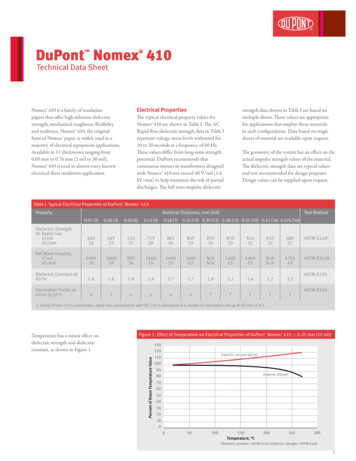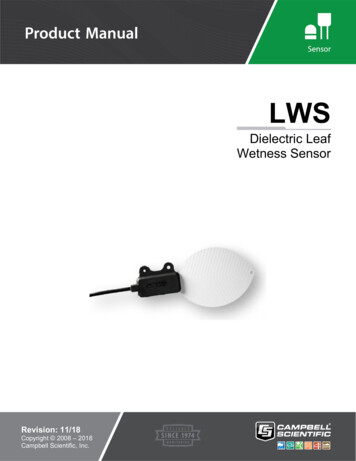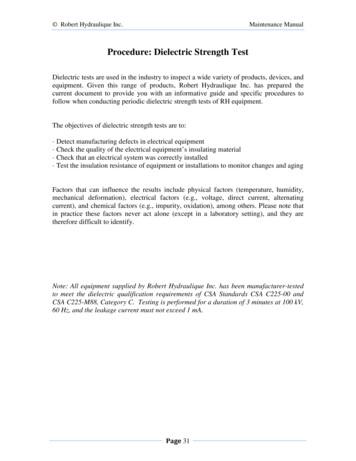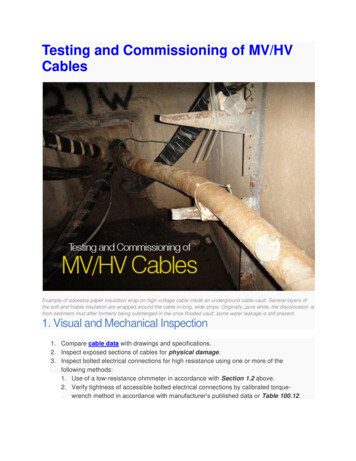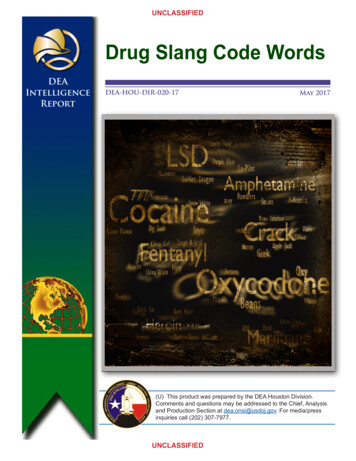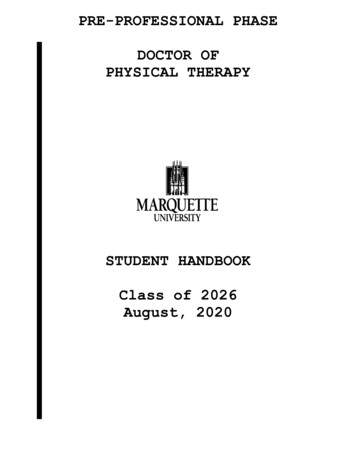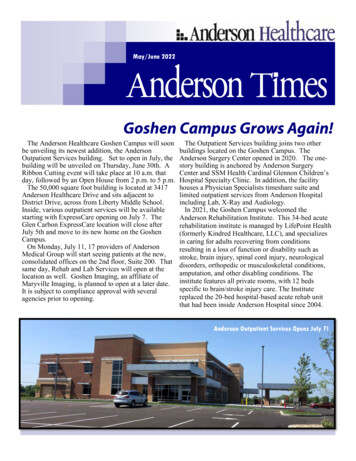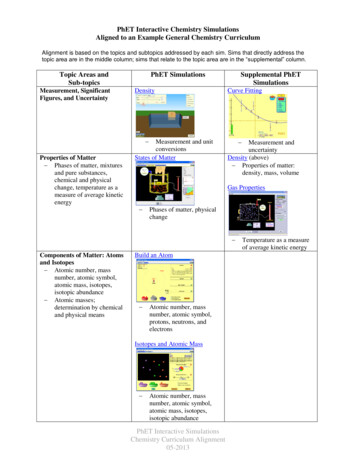
Transcription
DEA 288 Ionic – Dielectric Cure MonitoringMethod, Technique, ApplicationsAnalyzing & Testing
DEA 288 IonicOpening a New World of Cure MonitoringClear-Cut Determination of the Curing BehaviorDielectric Analysis (DEA), also known as Dielectric Thermal Analysis (DETA), is atechnique for monitoring changes in the viscosity and cure state of thermosettingresins, adhesives, paints, composites and other kinds of polymers or organicsubstances by measuring variations in their dielectric properties.DEA is the most powerful measurement technique for the critical, invisible in-moldcuring that dictates the quality of a component.2
DEA 288 Ionic: Portable version (left)and Rack version (right)Advantages of DEAThe Benefits to YouCustomized Test ConditionsDevelopment of Optimized Resin FormulationsThe DEA 288 Ionic comes as either a processimplementable "Rack" version or an all-purpose"Portable" version. For laboratory investigations,several accessories are available:Often, polymers achieve their full performancepotential only upon being combined with activeadditives. Such additives serve to adjust themorphology or the polymer architecture in atargeted manner. With the DEA 288 Ionic, theeffectiveness of accelerators, inhibitors, andantioxidants can be measured quickly and reliably,as can the impact of substances such as fillers. Suchinsight can have tremendous impact on efforts toshorten the development process. Laboratory furnace combinable with aUV-light sourceHumidity chamber and lab press for re-creatingconditions similar to those occurring in-processDesigned for Comfortable Sample HandlingDetermination of Ideal Process ParametersNo special sample preparation – as is often the casefor other measurement techniques – is necessary. Byapplying the wide range of available sensors, almostany practical application can be reproduced:The DEA 288 Ionic was originally designed specifically for use in laboratories – whether industrial oracademic (see page 6). However, the same instruments and sensors can also be used in manufacturing environments. The DEA 288 Ionic thus allowsfor the transfer of parameters developed in the labdirectly to production. Spray coating of thin filmsApplication by a drawbarSpreading of low- or medium-viscosity materialsPositioning of the sensor between the layersof a prepregDipping of the sensor in a liquidIn-mold cure monitoringThe following process parameters can bedetermined: ViscosityGel pointCure behavior3
What You Can Investigate with DEA Degree of CureGel-PointFlow BehaviorReactivityCure MonitoringDiffusion Properties Glass TransitionTemperatureProcess Monitoringand OptimizationAgingDecomposition EffectsTHE METHODDielectric (Thermal) AnalysisDEA (or DETA) TechniqueWithout external electrical fieldFundamental PrincipleThe functional principle isconsistent with that of animpedance measurement.With external electrical field Behavior of ions and dipoles inside an external electrical fieldIn a typical test, the sample isplaced in contact with twoelectrodes (the dielectric sensor).When a sinusoidal voltage isapplied, the charge carriers insidethe sample are forced to move:positively charged particlesmigrate to the negative pole andvice versa. This movement resultsin a sinusoidal current with aphase shift.In the frequency range of the DEA288 Ionic (up to 1 MHz), the charge4
ResultsAn outer electric field generated by an excitation voltage is applied to the sample and the response, occurring asa current through the material, is measured. Dipoles will be aligned and the ions will move towards the oppositelycharged electrode, which can be seen in ε' and ε'', respectively. Based on the sample's characteristics, a time shiftbetween excitation and response signal is detected that, together with voltage and current, allows for the calculation of dielectric magnitudes.Log Ion Visc. /Ohm.cmIn detail, this yieldsinformation about: Loss f.12(1 Hz)Ion viscosity11.0 min104Flow behaviorReactivityCure progress11103101029Loss factorApplication Areas ResearchProcess developmentProcess controlQuality control/assurancecarriers are mainly ions (oftenpresent as catalysts or impurities),but dipole alignment also takesplace within the electrical field.The response signals – current andphase shift – are a function of theion and dipole mobility. Thisrelationship makes dielectric(thermal) analysis an ideal methodfor cure monitoring, the sample'sviscosty is increasing dramatically.As a consequence, the mobility ofthe charge carriers decreases,followed by a correspondingattenuation of the amplitude andan increased phase shift in theresulting signal.1011 Hz10 Hz81001.9 min0100 Hz510Time /min1520Loss factor and ion viscosity depict the cure progress of a two-component epoxyadhesive at room temperature. The best flow behavior is reached at the lowestviscosity value at 1.9 min, the cure progress ends at 11 min. The slope of the ionviscosity increase is the reactivity during the cure progress.VoltageCurrent PhaseDEA – Measurement principle5
CHARACTERISTICSModular designSimultaneousmulti-channelmeasurementsHigh dataacquisition rateLeading-edgetechnologyDEA 288 Ionic, Rack versionCutting-Edge Technology –The Benchmark for Process ControlTwo versions of the DEA 288 Ionic areavailable:Portable VersionWith up to seven channels, this DEA is theflexible version for your day-to-day work. Itcan be easily transported between differentmeasurement locations.Rack Version for Integration into anIndustrial ProcessThe 19” Rack version is designed for anelectrical cabinet. It supports 8 simultaneousmeasuring channels which can be extendedup to 16 modules.DEA Ionic, Portable version with TMCc sensor andadaptor box for the connection of all disposable sensors6
The DEA 288 Ionic covers a wide range of measurement frequencies (from 1 mHz to 1 MHz) in order toaccurately determine the changes in dielectric properties during reaction. With their minimum dataacquisition time of less than 5 ms, the instruments can even handle fast curing systems such as UV curing.All devices come ready-equipped to be connected to thermocouples (separate or integrated into the DEAsensor) or to resistive temperature detectors (RTDs), so that the temperature data can be collected alongwith the dielectric information. Each channel has its own input.Key Technical SpecificationsDEA 288 IonicFrequency range1 mHz to 1 MHz, freely selectable valuesData acquisitionMultiple DEA modules; true simultaneousoperation of all channelsMinimum dataacquisition time 5 msSensor connectionDEA modulesI/O portsShielded 4-wire technique (compensationof resistivity and capacity of the wire as aprerequisite for precise measurements) Portable version: All-purpose version,up to 7 channelsIndustrial Rack version: up to 8 channels(extension possible for up to 16channels)Input and output of measuring signals orsignals from peripheral devices such aspressure or temperature sensors. DEAallows for triggering by manufacturingmachines.Adaptor box – fast, easyand reliable connectionof all disposable sensors,thermocouples or RTD sensorsDEA 288 Ionic Raises Your Process to the Next Level7
High FlexibilityBY MEANS OF SENSITIVE AND VERSATILESENSORS FOR ANY APPLICATIONReusable Coated ToolMountable CombElectrode for in-moldapplicationsIn order to meet the requirements of a multitude of polymer processingapplications, NETZSCH offers a great variety of dielectric sensors. These can beclassified as disposable and in-mold sensors. The latter type can be permanentlymounted, for example, into a press, a mold or even into a sample holder for bothDMA and rheometer.Implantable sensors are designed for one-time use and can be positioned at thedesired location within a part or simply coated with material. A typical implantablesensor subtype is the IDEX (interdigitated electrode) sensor.Most sensors are composed of two interdigitated comb electrodes on an inertsubstrate. The resulting field of measurement is a fringing pattern; a localizedmeasurement of the dielectric properties is carried out near the sensor/sampleinterface. The penetration depth of the electrical field lines into the sample is ofapproximately the same magnitude as the electrode spacing.Additionally, reusable sensors are available which use a parallel plate electrode configuration and determine the bulk properties of a sample material. The Monotrodesensor can act as one of these plate electrodes. The opposing piece can be, forexample, the corresponding grounded metal cover of a mold. If there is no mold orif the sample is very thick, the sensor housing acts as a second electrode.Very robust,implantable standard sensor(IDEX) with comb structureand an electrode distance of115 μmCourse of the fieldlines in comb sensors(left) and sensorswith parallel plateelectrodes (right)PolymerFringe field8Bulk field
For optimal matching to different mold geometries,NETZSCH offers both Monotrode and Tool Mount Sensorsin various diameters. The sensors contain an integratedthermocouple. Moreover, they are pressure-resistant andable to withstand temperatures of up to 220 C.By using a rugged cabling ( 20 m; theoretically unlimitedin length), it is also possible to measure samples which arelocated at a considerable distance from the DEA device –for example, for in-process tests.DEA furnace with installed Coated ToolMountable Comb ElectrodeSpecifications for Available Sensor SpacingMainApplicationMicron Sensor(MS)2.5 mm2,26 mm2,70 mm2200 C or350 C*1, 5 or 25 μmPaints, inks, adhesivesMini-IDEX(InterdigitatedElectrode)33 mm2275 C100 μmAll resins(small cavities)IDEX(InterdigitatedElectrode)2233 mm200 C or275 C*115 μmAll resins(epoxy, polyester PES,polyurethane PUR,etc.)IDEX, filtered233 mm2200 C or275 C*115 μmCarbon fiberreinforced polymers(CFRP)Tool MountableMonotrode(TMM)13 mm²,79 mm²,707mm²220 C–Especially for SMC/BMC, PUR foamsTool MountableComb Electrode(TMC)214 mm²220 C500 μmAll resins(EP, PES, PUR, etc.)500 μmAll resins, compositesand other polymerswith electricallyconductive fillersCoated ToolMountable CombElectrode (TMCc)254 mm²220 C* depending on the wiring of the sensor head9
SmartAccessoriesWHICH BRIDGE THEGAP BETWEEN PROCESS DEVELOPMENTAND PRODUCTIONCustomized Test ConditionsFor proper simulation of industrialscale processes, NETZSCH providesa series of pertinent add-ons to theDEA instrumentation, such as thelaboratory furnace with cooling,laboratory press, and UV lamp forfast curing reactions.DEA 288 Ionic with accessories10
LABPRESSLaboratory tests on Sheet Molding Compounds (SMCs), BulkMolding Compounds (BMCs) and prepregs can be performed inan environment mimicking processing conditions by using a labpress, which is able to apply heat and pressure to the sample atthe same time. The sample itself is either situated directlybetween the plates (including DEA sensor) or – optionally – in aseparate spring mold, equipped with a Monotrode or a TMSsensor. The temperature program of the press can becontrolled via the NETZSCH Proteus software from roomtemperature up to 350 C. The maximum force that can beapplied amounts to 10 kN.MULTI-FUNCTIONALLAB FURNACEWith the easy-to-operate lab furnace, it is possible to carry outheating, isothermal or cooling steps in the temperature rangefrom -140 C to 400 C by using either two IDEX (or MS) sensorsor a single TMS sensor. Cooling can be realized via air compressoror liquid nitrogen (LN2). To establish a defined gas atmosphereinside, two purge gases can be attached; these can be switchedby magnetic valves. The furnace is designed to be connected tothe fiber light guide of a UV lamp.Ion visc. /Ohm . cmTemp. / C109Ion visc. (1000,000 0350Time /minWith the DEA furnace, multiple temperature steps can be realizedUV LAMPThe DEA 288 Ionic system supports the OmniCure S2000 UVlamp for studying light-induced reactions such as the UV curingof adhesives, inks or paints. The duration and intensity of the UVexposure are software-controlled (via NETZSCH Proteus ).Multiple shots can be triggered during each segment. The fiberlight guide of the UV lamp is connected to the lab furnace.11
Proteus SoftwarePowerful and Easy to UseComprehensive Measurement and Evaluation SoftwareThe measuring part of the software provides the user with a modern, user-friendly operating interface. Proteus now offers a quick and convenient input assistant for programming all relevant measurement parameters. Colorcoded tabs facilitate data entry and guarantee that no important parameter is forgotten – whether it relates toinformation about the sample, the temperature/time program or the desired frequencies.Segments can be adapted (time, temperature, frequency) during a running measurement. In addition, a snapshotcan be taken to analyze the data recorded up until that point.Communication with certainaccessories can be activated witha simple click. The NETZSCHProteus software controls thetemperature profile of the labfurnace and triggers the UV lamp.User interface for programming a test runThe desired channels can be easily enabled byselecting the appropriate check box. Activechannels are colored green.Selection of a suitable sensor is very easy.The software contains a complete list of allavailable sensors, including their particulartechnical specifications. Importantparameters such as electrode spacing(distance) or A/D ratio (ratio between areaand distance) are automatically set togetherwith the sensor type. Additionally, sensorsmay be defined by the user.12
The well-proven Proteus software ensures comprehensive analysis. It allowsfor easy inputting of a measurement's parameters and features routines fordata acquisition and evaluation with maximum flexibility.General Software Features DEA variables: ion viscosity, ion conductivity, loss factor, permittivity phase,tanδ as a function of time/temperatureMultiple-method plot – comprehensive evaluation and presentation of, forexample, DEA, DSC and DMA curves in a single graph for detailed materialcharacterizationPicture-in-picture (PIP), 3-D plotSnapshot for evaluation of a measurement in progressDetermination of characteristic values such as peak or extrapolated onsetor endset, 1st derivative on a single curve or on a curve family, degree ofcure, percent cure, conversion curve, delta stepComparative analysis of up to 64 curves or segments from the same ordifferent measurementsRaw data preservation – original measurement data is always availableData and graphic exportThe software activates communication with accessories by mouse click.It controls the temperature profile of the lab furnace and lab press andtriggers the UV lamp.Screenshot of the analytical software13
Various ApplicationsIn-Process Characterization of a Sheet Molding Compound (SMC)The term SMC (Sheet Molding Compound) refers to areinforced composite material created by a specificprocess.A fiber-matrix semi-finished material, consisting of aresin (typically polyester or vinyl ester resins), choppedglass fibers, mineral fillers and additives, undergoes acompression molding process and cures underelevated temperature and pressure. The properties ofSMCs are defined in the European standard EN 14598.SMC parts are used in high quantities in the automotive industry, for example, as spoilers or trunklids. But they can also be found in the aeronauticsfield, in the electro/electronics sector, in the buildingindustry and in hobby and leisure (e.g., pieces ofsports equipment).14The advantages of sheet moldingcompounds are: Engineering of complex designspossible (whereby the thermalexpansion is similar to steel)Corrosion-resistantPaintableEconomicalLow in weightEspecially the last item is veryimportant to car manufacturers,because SMC parts are 20% - 30%lower in weight than their steelpanel counterparts, which isessential for a lightweight solution.
Log Ion Visc. /Ohm.cmTemp. / C1409.0120580.0s, 8.70 Ohm.cm135 C, 50 bar8.5580.0s, 8.49 Ohm.cm8.0135 C, 3 bar10080607.5117.3s, 117.2s, 7.22 Ohm.cm40143.6s, 143.4s, 7.18 Ohm.cm7.0100200300Time /s400500Comparison of the DEA results of two SMC samples; presentation of the log ion viscosity as asolid line and of the temperature as a dashed line. The temperature increase around 200 s iscaused by the heat generated during curing. The significant ion viscosities in linear scalingare 0.15E 08 and 3.1E 08 Ohm*cm for the 3-bar measurement, and 0.17E 08 and 5.0E 08Ohm*cm for the 50-bar one.In the present example, two SMC parts were analyzed in a press using atest mold with a Monotrode sensor at 135 C at two different pressures:3 bar (blue curves) and 50 bar (red curves). The sample thicknesses wereapprox. 5 mm and the measurement frequency for each test was 1000 Hz.It can clearly be seen that curing is accelerated at higher pressures. Theextrapolated onset temperature, indicating the working time beforethe curing process begins, takes place 27 seconds (about 20%) earlier inthe 50-bar measurement (red curve). Compared to the test run at 3 bar, itscurve ends up at a higher ion viscosity level (about 60%) at 580 s. Resultssuch as these are important in process optimization.15
Real-Time Analysis of the UV Curing Behavior16The light-induced curing of paints, inks, varnishes,adhesives, casting compounds and composites is ayoung but quickly growing technology. It is frequentlyapplied in the automotive industry, in electronics, inmedical engineering, in metal processing, and inmachine and plant manufacturing.Additionally, UV paints, printinginks and adhesives are usuallysolvent-free and therefore environmentally friendly.One characteristic of UV curing is that the reactionoccurs within a very short window of time – usuallyjust a few seconds. Further processing and qualitycontrol of the coated parts can then be carried outimmediately. In total, there are three differenttypes of curing systems:Radical curing systemsCationic curing systemsDual-cure systems (thermaland UV curing in one system)
Ion visc. /Ohm.cmEnd: 128.5s, 4659E 06 Ohm.cm101010910810710617.0s, 1.2E 06 Ohm.cm1050100200300Time /s400500600DEA measurement on a UV curing adhesive based on a modified epoxy resinThe graph shows the UV curing of a flexible sealant used for protectingorganic LEDs (OLEDs) and photovoltaics. It is a single-component EP resinwhich was applied onto an IDEX sensor as a thin film with a thickness of200 μm. The sensor was placed in the lab furnace, which in turn wasconnected to the light guide of a UV lamp.The light exposure was carried out with an irradiation time of 60 s and anintensity of 55 - 60 mW/cm2 UVA at room temperature. The employedfrequency was 1000 Hz. During UV treatment, only 17 s passed before theion viscosity curve began to rise, ending in a total increase of about4 orders of magnitude after approx. 400 seconds ( ca. 6.7 min).This result clearly demonstrates how DEA is also capable of detectingfast reactions.17
Resin Transfer Molding (RTM)Resin Transfer Molding (RTM) is another closedmolding technique for producing complex threedimensional shapes or sandwich structures (with, forexample, foams as the core material).In the RTM process, a mixture of liquid resin andcatalyst is injected into a closed mold alreadycontaining the dry reinforcing fibers such as mats orpreforms. After curing (at elevated temperature andmoderate pressure), the mold can be reopened andthe finished component removed.Depending on the application, the reinforcement mayconsist of natural fibers or fibers made of glass, carbonor aramid. Typical resins are of polyester, vinyl ester,epoxy or phenolic type. The selection of polymer andreinforcement dictates the mechanical and the surfacefinish performance of the molded part.RTM as a method is widely used in the automotiveindustry, for wind energy converters, in the constructionbusiness, in shipbuilding, in aviation, and in motorsports, among other areas. The primary objective hereis weight reduction.Ion visc. /Ohm.cmIn this example, a carbon fiberreinforced epoxy resin wasmeasured in a mold using acoated Tool Mountable CombElectrode (TMCc) at 80 C.Onset*: 258.3s, 2478E 08 Ohm.cm5Onset*: 98.2s, 1077E 08 Ohm.cm21011521010As depicted in the plot on theleft, curing took place in twosteps. The first one sweepsthrough more than 3 orders ofmagnitude in ion viscosity andreaches its plateau after approximately 170 s. A second curingstep was observed after 258 s.52109521085Peak: 38.1s, 0.2165E 08 Ohm.cm250.0100.0150.0200.0250.0Time /s300.0DEA result of a measurement on an epoxy based CFRP material18350.0400.0
Simultaneous DEA-DMAand DEA-RheologyAdvantages of SimultaneousMeasurementsSample holder for simultaneousDMA-DEA with Mini-IDEX sensor Resin flow (Rheology)Minimum viscosity (DEA/Rheology)Gelation (DMA/Rheology)Vitrification (Tg) (DMA)Reactivity (slope of the DEA curve)Completion of cure (DEA)Comprehensive Material Characterization viaCoupling of DEA with DMA or RheologySince the consistency of most thermosetting materials changescompletely during curing (e.g., from a liquid to a rigid solid), it isoften difficult to study all points of interest with only a singleanalytical technique.To address this issue, the DEA 288 Ionic can either be linked tothe NETZSCH DMA 242 E Artemis dynamic-mechanical analyzeror to a rheometer such as Mars III by Thermo Fisher Scientific toperform simultaneous DEA-DMA or DEA-Rheology measurements. This allows for results to be obtained from two complementary instruments in a single run, for advanced analysis.For DMA-DEA measurements, a special compression sampleholder is equipped with a Mini-IDEX sensor in an appropriateDMA container. Whereas the DMA is able to identify gelation andglass transition in a resin, the DEA is more sensitive in the area ofits minimum viscosity and at the end of the curing reaction.Combining dielectric (thermal) analysis with rheology expandsthe accessible frequency range from 10-3 Hz to 106 Hz. Thishelps to gain understanding about the flow properties ofresins – for example, during injection (resin transfer molding).DEA 288 Ionic with reusable TMCc sensor (combsensor with 0.5-mm electrode spacing), integratedin a MARS III Rheometer (plate-plate, gap 0.6 mm)19
The NETZSCH Group is an owner-managed, international technologycompany with headquarters in Germany. The Business Units Analyzing &Testing, Grinding & Dispersing and Pumps & Systems represent customizedsolutions at the highest level. More than 3,700 employees in 36 countries anda worldwide sales and service network ensure customer proximity andcompetent service.Our performance standards are high. We promise our customers ProvenExcellence – exceptional performance in everything we do, proven time andagain since 1873.NETZSCH-Gerätebau GmbHWittelsbacherstraße 4295100 SelbGermanyTel.: 49 9287 881-0Fax: 49 9287 881 505at@netzsch.comNGB · DEA 288 Ionic · EN · 0220 · NWS · Technical specifications are subject to change.When it comes to Thermal Analysis, Calorimetry (adiabatic & reaction) andthe determination of Thermophysical Properties, NETZSCH has it covered.Our 50 years of applications experience, broad state-of-the-art product lineand comprehensive service offerings ensure that our solutions will not onlymeet your every requirement but also exceed your every expectation.
Tool Mountable Monotrode (TMM) 13 mm², 79 mm², 707mm² 220 C - Especially for SMC/ BMC, PUR foams Tool Mountable Comb Electrode (TMC) 214 mm² 220 C 500 μm All resins (EP, PES, PUR, etc.) Coated Tool Mountable Comb Electrode (TMCc) 254 mm² 220 C 500 μm All resins, composites and other polymers with electrically conductive fillers
